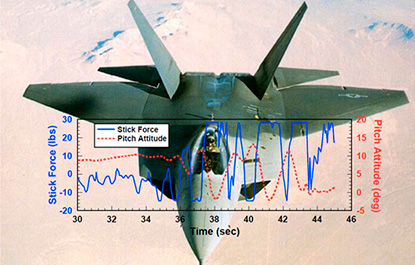Pilot-Induced Oscillations
Addressing the troubling phenomenon of pilot-induced oscillations (PIO) on prototype, experimental, and operational military and commercial aircraft.
Pilot-Induced Oscillations (PIO) are rare, unexpected, and unintended excursions in aircraft attitude and flight path caused by anomalous interactions between the aircraft and pilot. Throughout our history, Systems Technology has led the industry in comprehension, analysis, and prevention of this troubling phenomenon. Work began in the early 1960’s with high profile PIO events involving the T-38, F-4 Sageburner, and X-15.
Activity peaked again in the mid 1970’s with the Shuttle ALT-5 and F-16 Flight Zero events and in the early 1990’s with several severe events that were characterized by actuator rate limiting associated with flight control systems including the YF-22 and SAAB Gripen. Each generation featured advancement in prediction and analysis methods. Specific Systems Technology activities have included the analysis of PIO susceptibility for a wide range of military and commercial transport aircraft, the development of PIO-specific criteria and analysis techniques including nonlinear system methods, and the definition of flight test methods. Recent work has focused on PIO alleviation concepts including Smart-Cue/Smart-Gain and SAFE-Cue.
Sign up for Systems Technology’s two-day course: “Pilot-Induced Oscillations from the Wright Flyer to Fly-By-Wire.” Learn more.
With the advent of modern flight control systems, the potential for catastrophic PIO is on the rise.
In this two-day short course, the phenomenon of PIO will be examined from its origins to today’s events. With practical examples from flight research, flight test, and operational experience, the speakers identify the myriad causes of PIO and describe the cures available to the design engineer.
The YF-22 experienced a Category II PIO featured control surface rate limiting on a demonstration flight.
